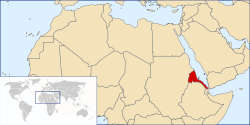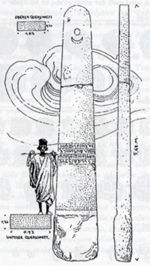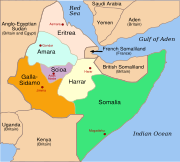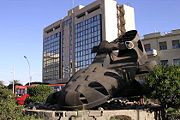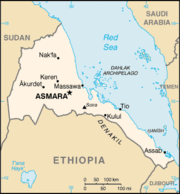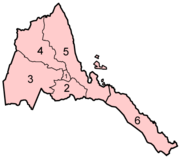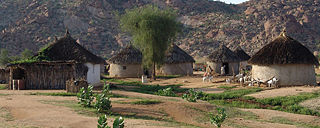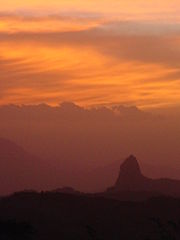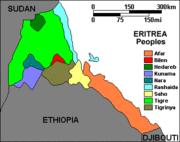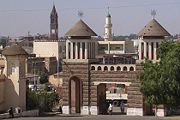Eritrea
2008/9 Schools Wikipedia Selection. Related subjects: Africa; African Countries
Without rendering support, you may see question marks, boxes or other symbols instead of Ethiopic characters. |
| Hagere Ertra ሃገረ ኤርትራ دولة إرتريا Dawlat Iritriya State of Eritrea
|
||||||
|---|---|---|---|---|---|---|
|
||||||
| Anthem: Ertra, Ertra, Ertra |
||||||
|
|
||||||
| Capital (and largest city) |
Asmara |
|||||
| Official languages | none at national level1 ( Tigrinya, Arabic) | |||||
| Demonym | Eritrean | |||||
| Government | Transitional government | |||||
| - | President | Isaias Afewerki | ||||
| Independence | from Ethiopia | |||||
| - | de facto | May 24, 1991 | ||||
| - | de jure | May 24, 1993 | ||||
| Area | ||||||
| - | Total | 117,600 km² ( 100th) 45,405 sq mi |
||||
| - | Water (%) | negligible | ||||
| Population | ||||||
| - | July 2005 estimate | 4,401,009 ( 118th) | ||||
| - | 2002 census | 4,298,270 | ||||
| - | Density | 37/km² ( 165th) 96/sq mi |
||||
| GDP ( PPP) | 2005 estimate | |||||
| - | Total | $4.471 billion ( 168th) | ||||
| - | Per capita | $1,000 ( 147) | ||||
| HDI (2007) | ▲ 0.483 (low) ( 157th) | |||||
| Currency | Nakfa ( ERN) |
|||||
| Time zone | EAT ( UTC+3) | |||||
| - | Summer ( DST) | not observed ( UTC+3) | ||||
| Internet TLD | .er | |||||
| Calling code | +291 | |||||
| 1 | Working languages: Tigrigna, Arabic, Italian,English , . | |||||
Eritrea (IPA: /ˌɛrɨˈtreɪə/, /ˌɛrɨˈtriːə/) ( Ge'ez: ኤርትራ ʾErtrā, Arabic: إرتريا Iritriya), officially the State of Eritrea, is a country situated in Northeast Africa. It is bordered by Sudan in the west, Ethiopia in the south, and Djibouti in the southeast. The east and northeast of the country have an extensive coastline on the Red Sea, directly across from Saudi Arabia and Yemen. The Dahlak Archipelago and several of the Hanish Islands are part of Eritrea.
Eritrea was conquered by Italy and formally consolidated into a colony by the Italian government on January 1, 1890. In 1936 it became a province of Italian East Africa (Africa Orientale Italiana), along with Ethiopia and Italian Somaliland. The British expelled the Italians in 1941.
Increasing unrest and resistance in Eritrea against the federation with Ethiopia eventually led to a decision by the Ethiopian government to annex Eritrea as its 14th province in 1962. An Eritrean independence movement formed in the early 1960s which later erupted into a 31 year long civil war against successive Ethiopian governments that ended in 1991. Following a UN supervised referendum in Eritrea dubbed UNOVER in which the Eritrean people overwhelmingly voted for independence from Ethiopia, Eritrea declared its independence and gained international recognition in 1993. Eritrea's constitution, adopted in 1997, stipulates that the state is a presidential republic with a unicameral parliamentary democracy. The constitution, however, has not yet been implemented fully due to, according to the government, the prevailing border conflict with Ethiopia which began in May 1998.
Eritrea is a multilingual and multicultural country with two dominant religions ( Coptic Orthodox Christianity and Islam) and nine ethnic groups. The country's dominant language is Tigrinya, natively spoken by around 50% of the population. Along with Tigrinya, Arabic and English are used for official communication. English is also used in all of the government's international communication and is the language of instruction in all education beyond 5th grade.
History
The oldest written reference to the territory now known as Eritrea is the chronicled expedition launched to the fabled Punt (or Ta Netjeru, meaning land of the Gods) by the Ancient Egyptians in the twenty-fifth century BC under Pharaoh Sahure. Later sources from the Pharaoh Hatshepsut in the fifteenth century BC present a more detailed portrayal of an expedition in search of incense. The geographical location of the missions to Punt is described as roughly corresponding to the southern west coast of the Red Sea.
Pre-history
One of the oldest hominids, representing a possible link between Homo erectus and an archaic Homo sapiens, was found in Buya (Eritrean Danakil) in 1995 by Italian scientists. The cranium was dated to over 1 million years old. Furthermore, the Eritrean Research Project Team, composed of Eritrean, Canadian, American, Dutch, and French scientists, discovered in 1999, some of the earliest remains in the world, of humans using tools to harvest marine resources, at a site near the bay of Zula south of Massawa. The site contained obsidian tools dated to over 125,000 years old, from the paleolithic era. Epipaleolithic or mesolithic cave paintings in central and northern Eritrea attest to early hunter-gatherers in this region.
A US paleontologist, William Sanders of the University of Michigan also discovered a possible missing link between ancient and modern elephants in the form of the fossilized remains of a pig-sized creature in Eritrea. Sanders claims that the dating of the fossil to 27 million years ago also pushes the origins of elephants and mastodons five million years further into the past than previously recorded and asserts that modern elephants originated in Africa, in contrast to mammals such as rhinos that had their origins in Europe and Asia and migrated into Africa. In addition to Sanders, the research team included scientists from the Elephant Research Foundation of Wayne State University in Michigan, USA, University of Asmara in Eritrea; Franklin and Marshall College in Lancaster, PA, USA; the Eritrean ministry of mines and energy; Global Resources in Asmara, Eritrea; the Muséum national d'histoire naturelle in Paris; the National Museum of Eritrea; and German Primate Centre in Gottingen, Germany.
Early history
The earliest evidence of agriculture, urban settlement and trade in Eritrea was found in the western region of the country consisting of archeological remains dating back to 3500 BC in sites called the Gash group. Based on the archaeological evidence, there seems to have been a connection between the peoples of the Gash group and the civilizations of the Nile Valley namely Ancient Egypt and Nubia. Ancient Egyptian sources also give references to cities and trading posts along the southwestern Red Sea coast, roughly corresponding to modern day Eritrea, calling this the land of Punt famed for its incense. Expeditions to this very land were launched by the Ancient Egyptians as early as the 25th century BC and were chronicled in more detail in later expeditions during the reign of the female Pharaoh Hatshepsut in the 15th century BC.
In the highlands, in the capital city Asmara's suburbs, scores of ancient sites have been documented, including Sembel, Mai Chiot, Ona Gudo, Mai Temenai, Weki Duba, and Mai Hutsa. Mostly dating to the early and mid-1st millennium BCE (800 to 350 BCE), these communities ranged from small towns, villages, and hamlets built of stone. People practiced a mixed economy of pastoralism and grain agriculture, but little evidence for trade with the outside world has been found. The proximity of these ancient communities to gold mines suggest that part of their prosperity is linked to mining and processing of gold. Around the mid-1st millennium, several sites with Sabaean remains (inscriptions, artifacts, monuments, etc.) seem to emerge in the central highlands, for example, at Keskese. There is evidence at Keskese that older remains, similar to those around Asmara, are present. The Sabaean remains, however, are not accompanied by evidence for residence of people from that southern Arabian kingdom. It appears to archaeologists that these remains represent the growth of local elites who appropriated powerful symbols from Saba in their quest for legitimacy.
Between the eighth and firth century BCE, a kingdom known as D'mt was supposedly established in what is today Eritrea and northern Ethiopia ( Tigray), with what some archaeologists speculate was its capital at Yeha in northern Ethiopia. Many speculative theories try to explain the presence of Sabaean material culture by saying that this area had extensive relations with the Sabaeans in present day Yemen across the Red Sea, but these views are not sustained by archaeological evidence. After D'mt's decline around the fifth century BC, the state of Aksum arose in much of Eritrea and northern Ethiopian Highlands. It grew during the fourth century BC and came into prominence during the first century AD, minting its own coins by the third century, converting in the fourth century to Christianity, as the second official Christian state (after Armenia) and the first country to feature the cross on its coins. According to Mani, it grew to be one of the four greatest civilizations in the world, on a par with China, Persia, and Rome. In the seventh century; with the advent of Islam across the Red Sea in Arabia, and the Arab invasion and subsequent destruction of Adulis, Aksum's trade and power on the Red Sea began to decline and the empire gradually diminished and overtaken by smaller rival Kingdoms.
Medieval history
During the medieval period, contemporary with and following the gradual disintegration of the Axumite state between the 9th and 10th centuries, several states as well as tribal and clan lands emerged in the area known today as Eritrea. Between the eighth and thirteenth century, northern and northwestern Eritrea had largely come under the domination of the Beja, a Cushitic people from northeastern Sudan. They formed five independent islamic kingdoms known as: Naqis, Baqlin, Bazin, Jarin and Qata. The Beja brought Islam to large parts of Eritrea and connected the region to the greater Islamic world dominated by the Ummayad Caliphate, followed by the Abbasid (and Mamluk) and later the Ottoman Empire. The Ummayads had taken the Dahlak archipelago by 702. Christians of the Axumite era continued nonetheless to inhabit these areas and retain their religion. The southeastern parts of Eritrea, inhabited by the independent Afar since ancient times, came to form part of the islamic sultanate of Adal in the early 13th century. Parts of the southwestern lowlands of Eritrea, were under the dominion of the then christian/animist Funj sultanate of Sinnar.
In the main highland area and adjacent coastline of what were previously moslem (Beja) ruled areas, there broke out a christian Kingdom called Midir Bahr or Midri Bahri (Tigrinya for land of the sea) ruled by the Bahr negus or Bahr negash, ("ruler of the sea") in the 15th century. Barely a century later, an invading force of the islamic Ottoman Empire, under Suleiman I, conquered Massawa in 1557 from the christians, building what is now considered the "old town" of Massawa on Batsi island. They also conquered the towns of Hergigo, and Debarwa, the capital city of the contemporary christian Bahr negus (ruler), Yeshaq. Suleiman's forces fought as far south as southeastern Tigray in Ethiopia before being repulsed. Yeshaq was able to retake much of what the Ottomans captured with Ethiopian assistance, but he later twice revolted against the Emperor of Ethiopia with Ottoman support. By 1578, all revolts had ended, leaving the Ottomans in control of the important ports of Massawa and Hergigo and their environs, and leaving the interior domains (province) which they had dubbed: " Habesh", to Beja Na'ibs (deputies). The Ottomans maintained their dominion over the coastal areas for nearly 300 years, absorbing the coastal areas of the disintegrated Adal sultanate as vassals in the 16th century. The Funj sultanate of Sinnar converted to Islam in the 16th century but maintained independent control of the southwestern areas of Eritrea until being absorbed into the Ottoman Empire in the early 19th century.
The extent of the islamic Beja's rule over the Eritrean interior from the 16th century and on, did not extend very far into the mainly christian highland (Kebessa) areas. With the feodal rule of the Bahr negash severely weakened, the area became dubbed Mereb Mellash by locals and neighboring Ethiopians alike, meaning "beyond the Mereb" (in Tigrinya). This name defined the territory as being north of the Mareb River which to this day is a natural boundary between the modern states of Eritrea and Ethiopia. Roughly the same area also came to be referred to as Hamasien in the nineteenth century. In these areas, feudal authority was particularly weak or inexistent and the autonomy of the landowning peasantry was particularly strong, a kind of Republic was prevalent, governed by local customary laws legislated by elected elder's councils (shimagile). In 1770, the Scottish researcher James Bruce describes Hamasien and Abyssinia as "different countries who are often fighting" (SUKE, p.25). The name Hamasien later came to designate a much smaller area in Eritrea, a province immediately surrounding the capital, until being absorbed into the new administrative divisions in 1994.
Colonial era
A Roman Catholic Priest by the name of Giuseppe Sapetto acting on behalf of a Genovese shipping company called Rubattino in 1869 purchased the locality of Assab from the Afar Sultan of Obock, an Ottoman vassal. This happened in the same year as the opening of the Suez Canal. In the ongoing Scramble for Africa, Italy as one of the European colonial powers, began vying for a possession along the strategic coast of what was to become the world's busiest shipping lane. With the approval of the Italian parliament and King Umberto I of Italy (later succeeded by his son Victor Emmanuel III), the government of Italy bought the Rubattino company's holdings and expanded its possessions northward along the Red Sea coast toward and beyond Massawa, encroaching on and quickly expelling previously 'Egyptian' possessions. The Italians met with stiffer resistance in the Eritrean highlands from the invading army of the Ethiopian Emperor Yohannes IV of Ethiopia.
Nevertheless the Italians consolidated their possessions into one colony, henceforth known as Eritrea, territory of Italy as of New Years Day 1890. This led to Italy's first attempt to colonize Ethiopia, under prime minister Francesco Crispi. Italy had offered to make Ethiopia an Italian protectorate, Emperor Menelik of Ethiopia on the other hand, was intent, like his predecessors, on creating an Ethiopian empire of his own by laying claims to- and invading surrounding territories in competition with the European colonialists. He subsequently declared war on the Italians, defeating an Italian incursion on Ethiopian territory at Adowa in 1896. Upon the treaty with Italy, Emperor Menelik II in 1889 stated
The territories north of the Merab Melash (Modern Eritrea) do not belong to nor are under my rule. I am the Emperor of Abyssinia. The lands referred to as Eritrea is not peopled by Abyssinians, they are Adals, Bejas, and Tigres. Abyssinia will defend her territories but it will not fight for foreign lands of which Eritrea is to my knowledge.
Italy refrained from further attempts at invading Ethiopia, until 1935, when under Fascism and Mussolini, Italy attempted to conquer Ethiopia again, this time fighting against Emperor Haile Selassie - using its colonies of Eritrea and Italian Somaliland as its base, Italy was successful in conquering Ethiopia. The Kingdom of Italy ruled Eritrea from 1890 to 1940. In 1936, fascist dictator Benito Mussolini created the Italian Empire ( Italian East Africa), with the union of Eritrea, Ethiopia and Italian Somaliland. Eritrea enjoyed considerable industrialization and development of modern infrastructure during Italian rule (such as roads and the Eritrean Railway).
The Italians remained the colonial power in Eritrea throughout the lifetime of fascism and the beginnings of World War II when they were defeated by Allied forces in 1941, and Eritrea came under British administration. Noted artist Aldo Giorgini was a young child caught up in this difficult transitional period, and his experiences during this time became a recurrent theme in his artwork. The best Italian colonial forces were the Eritrean Ascari, who were defined by Amedeo Guillet as "the Prussians of Africa, but without the defects of the Prussians". They actively supported even the Italian guerrilla against the British between 1941 and 1943.
After the war, the United Nations conducted a lengthy inquiry regarding the status of Eritrea, with the superpowers each vying for a stake in the state's future. Britain, the last administrator at the time, put forth the suggestion to partition Eritrea between Sudan and Ethiopia, separating Christians and Muslims. The idea was instantly rejected by Eritrean political parties as well as the UN. The United States point of view was expressed by its then chief foreign policy advisor John Foster Dulles who said:
From the point of view of justice, the opinions of the Eritrean people must receive consideration. Nevertheless, the strategic interests of the United States in the Red Sea Basin and considerations of security and world peace make it necessary that the country [Eritrea] be linked with our ally, Ethiopia.
—John Foster Dulles, 1952
A UN plebiscite voted 46 to 10 to have Eritrea be federated with Ethiopia which was later stipulated on December 2, 1950 in resolution 390 (V). Eritrea would have its own parliament and administration and would be represented in what had been the Ethiopian parliament and would become the federal parliament. In 1961 the 30-year Eritrean Struggle for Independence began, following the Ethiopian Emperor Haile Selassie I's dissolution of the federation and shutting down of Eritrea's parliament. The Emperor declared Eritrea the fourteenth province of Ethiopia in 1962.
Struggle for independence
Eritreans formed the Eritrean Liberation Front (ELF) and rebelled. The ELF was initially a conservative grass-roots movement dominated by Muslim lowlanders and thus received backing from Arab socialist governments such as Syria and Egypt. Ethiopia's imperial government received support from the United States which had established a radio listening base (the Kagnew base) in Eritrea's Ethiopian-occupied capital, Asmara. Internal divisions within the ELF based on religion, ethnicity, clan and, sometimes, personalities and ideologies, led to the weakening and factioning of the ELF from which sprung the Eritrean People's Liberation Front. The EPLF professed Marxism and egalitarian values devoid of gender, religion, or ethnic bias. Its leadership was educated in China. It came to be supported by a growing Eritrean diaspora. Bitter fighting broke out between the ELF and EPLF during the late 1970s and 1980s for dominance over Eritrea. The ELF continued to dominate the Eritrean landscape well into the 1970s when the struggle for independence neared victory due to Ethiopia's internal turmoil caused by a socialist revolution against monarchy there.
The ELF's gains suffered when Ethiopia's ailing US-backed Emperor was deposed and replaced by the Derg, a Marxist military junta with backing from the Soviet Union and other communist countries, who continued the Ethiopian policy of repressing Eritrean "separatists" with increased military assistance and fervour. Nevertheless, the Eritrean resistance which saw itself forced to retreat from most of the Eritrean countryside it had previously occupied, became instead entrenched in the northern parts of the country around the Sudanese border from where the most important supply lines came. The heavily bombarded and embattled northern town of Nakfa came to symbolize the Eritrean struggle. (The Eritrean currency is named after it.)
The numbers of the EPLF swelled in the 1980s as did that of Ethiopian resistance movements with which the EPLF struck alliances to overthrow the communist Ethiopian regime, weakening and all but annihilating the precursor ELF. However, due to their own Marxist orientation, neither EPLF nor any of the Ethiopian resistance movements were able to acquire any significant US/Western or Arab support against the Soviet backed might of the Ethiopian military which has since been sub-Saharan Africa's largest, outside of South Africa. The EPLF relied largely on armaments captured from the Ethiopian army itself as well as financial and political support from the Eritrean diaspora and the cooperation of neighbouring states hostile to Ethiopia such as Somalia and Sudan (although the support of the latter was briefly interrupted and turned into hostility against EPLF and Eritrean refugees at large, in agreement with Ethiopia during the Gaafar Nimeiry administration between 1971 and 1985).
Drought, famine, and intensive offensives launched by the Ethiopian army on Eritrea took a heavy toll on the population — more than half a million fled to Sudan as refugees. Amid the culmination of Soviet support to Ethiopia and a major fall-out between Eritrean and Ethiopian anti-government rebels, the EPLF achieved two of its greatest and most decisive victories alone and unsupported. In 1985, Eritrean elite commandos infiltrated the Ethiopian and Soviet held air force base in Asmara and destroyed all 30 fighter jets there, suffering only one casualty. In 1988 during a massive Ethiopian military offensive against Eritrean rebels, a third of the Ethiopian army was annihilated in the northern Eritrean town of Afabet.
Following the decline of the Soviet Union in 1989 and diminishing support for the Ethiopian war, Eritrean rebels advanced further, capturing the port of Massawa and putting the Ethiopian and Soviet naval capabilities there out of action. By 1990 and early 1991 virtually all Eritrean territory had been liberated by EPLF except for the capital, whose only connection with the rest of government-held Ethiopia during the last year of the war was by an air-bridge. In 1991, Eritrean and Ethiopian rebels jointly held the Ethiopian capital under siege as the Ethiopian president Mengistu Haile Mariam fled to Zimbabwe where he lives to this day despite requests for extradition by both Eritrea and Ethiopia.
The Ethiopian army finally capitulated and Eritrea was completely in Eritrean hands in May 24, 1991 when the rebels marched into Asmara while Ethiopian rebels with Eritrean assistance overtook the government in Ethiopia. The new Ethiopian government conceded to Eritrea's demands to have an internationally (UN) supervised referendum dubbed UNOVER to be held in Eritrea which ended in April 1993 with an overwhelming vote by Eritreans for independence. Independence was declared on May 24, 1993.
Independence
Upon Eritrea's declaration of independence, the leader of the EPLF, Isaias Afewerki, became Eritrea's first Provisional President, and the Eritrean People's Liberation Front (later renamed the People's Front for Democracy and Justice, or PFDJ) created a government.
Faced with limited economic resources and a country shattered by decades of war, the government embarked on a reconstruction and defense effort later called the Warsai Yikalo Program based on the labour of national servicemen and women. It is still ongoing and deploys the enlisted into a combination of duties ranging from military service to construction projects, health care, teaching and training/education as well as agricultural work to improve the country's food security.
The government also attempts to tap into the resources of the Eritreans living abroad by levying a 2% tax on the gross income of those who wish to gain full economic rights and access as citizens in Eritrea (land ownership, business licenses and other privileges for nationals etc). while at the same time encouraging tourism and investment both from Eritreans living abroad and other foreign investors.
This has been complicated by Eritrea's tumultuous relations with its neighbours, lack of stability and subsequent political problems.
Eritrea severed diplomatic relations with Sudan in 1994 citing that the latter was hosting islamic terrorist groups to destabilize Eritrea and both countries entered into an acrimonious relationship, each accusing the other of hosting various opposition rebel groups or "terrorists" and soliciting outside support to destabilize the other. Diplomatic relations were resumed over 10 years later in 2005 following a reconciliation agreement reached with the help of Qatar's negotiation in 1999. Eritrea now plays a prominent role in the internal Sudanese peace and reconciliation effort.
Eritrea was also embroiled in a brief war with Yemen over a border dispute surrounding the Hanish Islands in 1996 which was later resolved by the Permanent Court of Arbitration in The Hague in 1998. Yemen was granted full ownership of the larger islands while Eritrea was awarded the peripheral islands to the southwest of the larger islands. Relations between both states have since normalized.
Perhaps the conflict with the deepest impact on independent Eritrea has been the renewed hostility with Ethiopia. In 1998, a border war with Ethiopia over the town of Badme occurred. The Eritrean-Ethiopian War ended in 2000 with a negotiated agreement known as the Algiers Agreement, which assigned an independent, UN-associated boundary commission known as the Eritrea-Ethiopia Boundary Commission (EEBC), whose task was to clearly identify the border between the two countries and issue a final and binding ruling. Along with the agreement the UN established a Temporary Security Zone consisting of a 25 kilometre demilitarized buffer zone within Eritrea running along the length of the disputed border between the two states and patrolled by UN troops in the mission named UNMEE. Ethiopia was to withdraw to positions held before the outbreak of hostilities in May of 1998 there among Badme. The peace agreement would be completed with the implementation of the Border Commission's ruling, also ending the task of the peacekeeping mission of UNMEE. The EEBC's verdict came in April 2002 which awarded Badme to Eritrea. However, Ethiopia refused to withdraw its military from positions in the disputed areas, including Badme, and also refused to implement the EEBC's ruling and the dispute is ongoing. Eritrea's diplomatic relations with Djibouti were briefly severed during the border war with Ethiopia in 1998 due to a dispute over Djibouti's intimate relation with Ethiopia during the war but were restored and normalized in 2000.
Regions and districts
Eritrea is divided into six regions (zobas) and subdivided into districts ("sub-zobas"). The geographical extent of the regions is based on their respective hydrological properties. This a dual intent on the part of the Eritrean government: to provide each administration with sufficient control over its agricultural capacity and eliminate historical intra-regional conflicts.
The regions, followed by the sub-region, are:
| No. | Region (ዞባ) | Sub-region (ንኡስ ዞባ) |
|---|---|---|
| 1 | Central (ዞባ ማእከል) |
Berikh, Ghala-Nefhi, Semienawi Mibraq, Serejaka, Debubawi Mibraq, Semienawi Mi'erab, Debubawi Mi'erab |
| 2 | Southern (ዞባ ደቡብ) |
Adi Keyh, Adi Quala, Areza, Debarwa, Dekemhare, Mai Ayni, Mai Mne, Mendefera, Segeneiti, Senafe, Tserona |
| 3 | Gash-Barka (ዞባ ጋሽ ባርካ) |
Agordat, Barentu, Dghe, Forto, Gogne, Haykota, Logo-Anseba, Mensura, Mogolo, Molki, Guluj, Shambuko, Tesseney, La'elay Gash |
| 4 | Anseba (ዞባ ዓንሰባ) |
Adi Tekelezan, Asmat, Elabered, Geleb, Hagaz, Halhal, Habero, Keren City, Kerkebet, Sel'a |
| 5 | Northern Red Sea (ዞባ ሰሜናዊ ቀይሕ ባሕሪ) |
Afabet, Dahlak, Ghel'alo, Foro, Ghinda, Karura, Massawa, Nakfa, She'eb |
| 6 | Southern Red Sea (ዞባ ደቡባዊ ቀይሕ ባሕሪ) |
Are'eta, Central Dankalia, Southern Dankalia, Assab |
Politics and government
Eritrea is a single-party state, run by the People's Front for Democracy and Justice (PFDJ). Other political groups are allowed to organise, although the non-implemented Constitution of 1997 provided for the existence of multi-party politics. The National Assembly of 150 seats (of which 75 were occupied by handpicked EPLF guerilla members while the rest went to local candidates and diasporans more or less sympathetic of the regime), formed in 1993 shortly after independence, "elected" the current president, Isaias Afewerki. No time frame was announced for the alleged obscure presidency. National elections have been periodically scheduled and cancelled; none have ever been held in the country. Independent local sources of political information on Eritrean domestic politics are scarce; in September 2001 the government closed down all of the nation's privately owned print media, and outspoken critics of the government have been arrested and held without trial, according to various international observers, including Human Rights Watch and Amnesty International. In 2004 the U.S. State Department declared Eritrea a Country of Particular Concern (CPC) for its alleged record of religious persecution (see below). In 2007, Reporters Without Borders, ranked Eritrea bottom in the world for overall press freedom in its annual study.
National elections
Eritrean National elections were set for 1995 and then postponed until 2001; it was then decided that because 20% of Eritrea's land was under occupation that elections would be postponed until the resolution of the conflict with Ethiopia. However, local elections have continued in Eritrea. The most recent round of local government elections were held in May 2004. On further elections, the President's Chief of Staff, Yemane Ghebremeskel said,
| “ | The electoral commission is handling these elections this time round so that may be the new element in this process. The national assembly has also mandated the electoral commission to set the date for national elections, so whenever the electoral commission sets the date there will be national elections. It's not dependent on regional elections, although that might be a very helpful process. Multipartyism, in general principle yes, it is there but the law on political parties has to be approved by the national assembly. It was not approved the last time. The view from the beginning was that you don't necessarily need a party law to hold national elections. You can have national elections and the party law can be adopted at any time. So in terms of commitment it's very clear, in terms of the process it has its own pace, its own characteristics. |
” |
Foreign relations
Eritrea is a member in good standing of the African Union (AU), the successor of the Organization of African Unity (OAU). But it has withdrawn its representative to the AU in protest of the AU's lack of leadership in facilitating the implementation of a binding border decision demarcating the border between Eritrea and Ethiopia. Eritrea's relationship with the United States is complicated. Although the two nations have a close working relationship regarding the on-going war on terror, there has been a growing tension in other areas. As of September 2007, relations with the US appear to be worsening. US Assistant Secretary of State, Jendayi Frazer,has called the nation a 'state sponsor of terrorism' and the US government is considering adding Eritrea to its list of rogue states, along with Iran, North Korea and Cuba. The reason for this is the presence of Sheikh Hassan Dahir Aweys, an exiled Somali Islamist leader, whom the US suspects of having links to Al Qaeda, at a recent Somalian opposition conference in Asmara. Economic sanctions against Eritrea could soon follow. Eritrea's relationship with Italy and the EU has become equally strained in many areas in the last three years.
Within the region, Eritrea's relations with Ethiopia turned from that of close alliance to a deadly rivalry that led to a war from May 1998 to June 2000 in which approximately 19,000 Eritreans and 123,000 Ethiopians were killed.
External issues include an undemarcated border with Sudan, a war with Yemen over the Hanish Islands in 1996, and a recent border conflict with Ethiopia.
The undemarcated border with Sudan poses a problem for Eritrean external relations. After a high-level delegation to Sudan from the Eritrean Ministry of Foreign Affairs, ties are being normalized. Meanwhile, Eritrea has been recognized as a broker for peace between the separate factions of the Sudanese civil war. "It is known that Eritrea played a role in bringing about the peace agreement [between the Southern Sudanese and Government]," while the Sudanese Government and Eastern Front rebels have requested Eritrea to mediate peace talks.
A dispute with Yemen over the Hanish Islands in 1996 resulted in a brief war. As part of an agreement to cease hostilities the two nations agreed to refer the issue to the Permanent Court of Arbitration at the Hague. At the conclusion of the proceedings, both nations acquiesced to the decision. Since 1996 both governments have remained wary of one another but relations are relatively normal.
The undemarcated border with Ethiopia is the primary external issue facing Eritrea. This led to a long and bloody border war between 1998 and 2000. As a result, the United Nations Mission in Ethiopia and Eritrea ( UNMEE) is occupying a 25 kilometers by 900 kilometers area on the border to help stabilize the region. Disagreements following the war have resulted in stalemate punctuated by periods of elevated tension and renewed threats of war. Central to the continuation of the stalemate is Ethiopia's failure to abide by the border delimitation ruling and reneging on its commitment to demarcation. The stalemate has led the President of Eritrea to urge the UN to take action on Ethiopia. This request is outlined in the Eleven Letters penned by the President to the United Nations Security Council. The situation is further escalated by the continued effort of the Eritrean and Ethiopian leaders in supporting each other's opposition. On July 26, 2007, the Associated Press reported that Eritrea had been supplying weapons to the Somali insurgent group Al-Shabaab, but no evidence was discovered, who is allegedly tied to al Qaeda. The incident has fueled concerns that Somalia may become the grounds for a de-facto war between Eritrea and Ethiopia, who invaded Somalia in December 2006 with U.S. assistance to overthrow the rule of the widely popular Islamic Courts Union which had stabilized the country and unified the capital Mogadishu for the first time since 1991. Amid fears of an emerging islamic and nationalist Somalia, Ethiopia with US assistance invaded Somalia, putting in place the weak and locally unpopular UN/ AU-backed government which without Ethiopian support had been unable to exercise any control beyond its base in Baidoa and along the Ethio-Somali border. For its part, Eritrea is hosting members of the ousted Union of Islamic Courts and the Somali Free Parliament. The Eritrean government has been accused of sponsoring, arming and hosting numerous militant leaderships and separatist rebels in the horn of Africa. According to the United States, the Isaias's government is "sponsoring and supporting the rebel groups" who are "also attacking civilians and are a part of the problem in Darfur." Thus, even though the Eritrean government bringing these same rebels to the table is positive, the US claims that the Eritrean government is doing this "by effectively destabilizing Sudan, because they're paying for rebels who are part of the process of destabilizing that country." The United States is considering to label Eritrea a state sponsor of terrorism which carries sanctions with it.
Army
Geography
Eritrea is located in East Africa, more specifically the Horn of Africa, and is bordered on the northeast and east by the Red Sea. The country is virtually bisected by one of the world's longest mountain ranges, the Great Rift Valley, with fertile lands to the west and the descent to desert in the East. Off the sandy and arid coastline is situated the Dahlak Archipelago and its fishing grounds. The land to the south, in the highlands, is slightly drier and cooler. Eritrea at the southern end of the Red Sea is the home of the fork in the rift.
The Afar Triangle or Danakil Depression of Eritrea is the probable location of a triple junction where three tectonic plates are pulling away from one another: the Arabian Plate, and the two parts of the African Plate (the Nubian and the Somali plate) splitting along the East African Rift Zone (USGS). The highest point of the country, Emba Soira, is located in the centre of Eritrea, at 9,902 ft (3,018 metres ) above sea level.
The main cities of the country are the capital city of Asmara and the port town of Asseb in the southeast, as well as the towns of Massawa to the east, and Keren to the north.
Environment
Eritrea formerly supported a large population of elephants. Ptolemaic kings of Egypt used it as a source of war elephants in the third century BC. Between 1955 and 2001 there were no reported sightings of elephant herds, and they were thought to have fallen victim to the war of independence. In December 2001 a herd of about 30, including 10 juveniles, was observed in the vicinity of the Gash River. The elephants seemed to have formed a symbiotic relationship with olive baboons. It is estimated that there are around 100 elephants left in Eritrea, the most northerly of East Africa's elephants.
In 2006, Eritrea announced it would become the first country in the world to turn its entire coast into an environmentally protected zone. The 1,347 km (837 mile) coastline, along with another 1,946 km (1,209-miles) of coast around its more than 350 islands, will come under governmental protection.
Economy
Like the economies of many other African nations, the economy is largely based on subsistence agriculture, with 80% of the population involved in farming and herding. The only natural disaster that sometimes affects Eritrea, drought, has often created trouble in the farming areas.
The Eritrean-Ethiopian War severely hurt Eritrea's economy. GDP growth in 1999 fell to less than 1%, and GDP decreased by 8.2% in 2000. The May 2000 Ethiopian offensive into southern Eritrea caused some $600 million in property damage and loss, including losses of $225 million in livestock and 55,000 homes. The attack prevented planting of crops in Eritrea's most productive region, causing food production to drop by 62%.
Even during the war, Eritrea developed its transportation infrastructure, asphalting new roads, improving its ports, and repairing war-damaged roads and bridges as a part of the Warsay Yika'alo Program. The most significant of these projects was the building of a coastal highway of more than 500 km connecting Massawa with Asseb as well as the rehabilitation of the Eritrean Railway. The rail line now runs between the Port of Massawa and the capital Asmara.
Eritrea's economic future remains mixed. The cessation of Ethiopian trade, which mainly used Eritrean ports before the war, leaves Eritrea with a large economic hole to fill. Eritrea's economic future depends upon its ability to master fundamental social problems like illiteracy, and low skills.
As of May 6th, 2008 Eritrea is the most expensive place in the world to buy fuel. At $9.58 per gallon, gasoline is 85c a gallon higher than in the next most expensive country, Norway.
Society
Demographics
Eritrean society is ethnically heterogeneous. Independent census has yet to be conducted but the Tigrinya people and the Tigre people together make up about 80%. These form the bulk of the country's predominantly Semitic population which are thought to have originated from massive migrations from Saba in Southern Arabia between 900 and 500 BC. The Sabean area in Eritrea is mainly to be found in the Kebessa highlands in central and northern Eritrea. There the Sabeans found the same geographical conditions as in their native Saba, suitable to terracing and their pre-existing agricultural modes of production. Later more recent migrations from Arabia includes the Arabic speaking Rashaida who arrived in Eritrea in the late 19th century and comprise less than 1% of the population.
The rest of the population comprises the smaller nations of the Saho, Hedareb, Afar, Bilen who constitute the cushitic stock of the population and are thought to be some of the oldest inhabitants of the Horn of Africa region along with the nilotic peoples who are represented in Eritrea by the Kunama and Nara.
Each nationality speaks a different native tongue but, typically, many of the minorities speak more than one language.
There exist minorities of Italians and Ethiopian Tigrayans. Neither is generally given citizenship unless through marriage or even more rarely: having it conferred upon them by the State.
The most recent addition to the nationalities of Eritrea is the Rashaida. The Rashaida came to Eritrea in the 19th century from the Arabian Coast. The Rashaida do not typically intermarry, are typically nomadic, and number approximately 61,000, less than 1% of the population.
The Kunama are one of the earliest settled peoples in Eritrea. They adopted rain-fed agriculture and settled into communal villages in the "lowlands" of Eritrea.
Languages
Many languages are spoken in Eritrea today.The country has two official languages Tigrinya and Arabic. Italian and English are also widely understood . The two language families that most of the languages stem from are the Semitic and Cushitic families. The Semitic languages in Eritrea are Arabic (spoken natively by the Rashaida Arabs), Tigre, Tigrinya, and the newly recognized Dahlik; these languages (primarily Tigre and Tigrinya) are spoken as a first language by over 80% of the population. The Cushitic languages in Eritrea are just as numerous, including Afar, Beja, Blin, and Saho. Kunama and Nara are also spoken in Eritrea and belong to the Nilo-Saharan language family. English is spoken to a degree by more educated Eritreans. Italian is a legacy of colonial times.
The local Tigrinya and the wider Arabic language are the two predominant languages for official purposes.
Education
There are five levels of education in Eritrea: pre-primary, primary, middle, secondary, and post-secondary. There are nearly 238,000 students in the primary, middle, and secondary levels of education. There are approximately 824 schools in Eritrea and two universities (University of Asmara and the Institute of Science and Technology) as well as several smaller colleges and technical schools.
One of the most important goals of Eritrea's education policy is to provide basic education in each of Eritrea's mother tongues, as well as to develop a self-motivated and conscientious population to fight poverty and disease. Furthermore it is tooled to produce a society that is equipped with the necessary skills to function with a culture of self-reliance in the modern economy.
The education system in Eritrea is also designed to promote private sector schooling, equal access for all groups (i.e., prevent gender discrimination, ethnic discrimination, and class discrimination, etc.) and promote continuing education, both formally and informally.
Barriers to education in Eritrea include traditional taboos, school fees (for registration and materials), and the opportunity costs of low-income households.
Religion
Eritrea has two dominant religions, Islam and Christianity, with approximately half of the population belonging to each faith. Most Muslims follow Sunni Islam. The Christians consist primarily of the Eritrean Orthodox Tewahdo Church, which is the local Oriental Orthodox church, but small groups of Roman Catholics, Protestants, and other denominations also exist.
Since May 2002, the Government of Eritrea has officially recognized the Eritrean Orthodox Tewahdo Church, Sunni Islam, Catholicism, and the Evangelical Lutheran church. All other faiths and denominations are required to undergo a registration process. Among other things, the Government's registration system requires religious groups to submit personal information on their membership to be allowed to worship. The few organisations that have met all of the registration requirements have still not received official recognition.
Other faith groups such as the Jehovah's Witnesses, Bahá'í Faith, the Seventh-day Adventist Church, and numerous Protestant denominations are not registered and cannot worship freely. They have effectively been banned, and measures have been taken against their adherents. Many have been incarcerated for months or even years. None have been charged officially or given access to the judicial process. In its 2006 religious freedom report, the U.S. State Department for the third year in a row named Eritrea a "Country of Particular Concern", designating it one of the worst violators of religious freedom in the world.
There is one last native Jew in Eritrea, formerly from a community of hundreds in Asmara, whose ancestors had crossed from Aden in the late 19th century.


